The 2022 Global State of IT Automation report, co-created by Stonebranch and IEEE Computer Society, highlights the latest research, trends, and benchmarks to help organizations excel in automation and orchestration. Based on a survey of automation-focused IT professionals worldwide, the report offers a unique perspective on the convergence of automation with cloud, DataOps, DevOps, and hybrid IT topics. Read on to learn about the key findings.
Automation Programs Are Growing and Evolving Due to Multi-Cloud and Hybrid IT Environments
According to the study, nearly half (46%) of all mid-size and large enterprise organizations operate in hybrid IT environments that include on-premises, cloud (public and private), and containerized microservices. In addition, approximately 90% report using multiple public and private clouds.
To overcome the new layer of cloud complexity, organizations are rethinking how they orchestrate workflows and data transfers across systems located in on-premises and cloud environments — 88% plan to grow their automation program over the next 12 months. Much of this growth is an evolution from on-premises automation to hybrid IT orchestration: 43% of enterprises will invest in a service orchestration and automation platform (SOAP) by the end of 2022, only two years after Gartner coined the SOAP category in 2020.

Successful Data Pipelines Require Integration and Orchestration
The hybrid model is a key requirement in data pipelines as well. While 90% of enterprises have more than half their data pipeline tools in the cloud, 73% rely on on-premises data management tools. Data sources and tools are changing frequently, too. 78% report adding and removing data sources and tools from their pipeline at least quarterly, if not more often. The agile nature of data pipelines is enabled by the cloud; the need for pipelines to extend beyond a single hosting environment is driving this need for more sophisticated orchestration.
Integrations are critical to navigating the current state of flux in the data environments, sources, and tools. As a result, the ease by which an enterprise can connect their automation and orchestration platform with constantly changing third-party applications and data storage tools has become a critical aspect of new vendor/platform selection.
The big takeaway is that data architects and engineers are eager to achieve true data pipeline orchestration that centralizes the design and management of automated processes existing in multiple tools.

IT Automation Responsibilities Extend Well Beyond the Central IT Team
The guidance and leadership of a centralized IT automation team cannot be understated. 93% of enterprises report having a centralized IT automation team, even as adoption of federated (or center of excellence) models has grown to 36%. Though it might seem counter-intuitive, the survey indicates that as central automation teams get bigger, they’re more likely to adopt a federated IT model.
Why is this?
Larger central teams help democratize IT automation and enable citizen automators by defining standards, implementing reusable automation components, and promoting best practices. This eliminates tribal knowledge and drives people to use a core set of tools. 84% of organizations offer a self-service automation portal to users across the business.
The democratization of IT is especially evident in cloud operations, where 91% of respondents reported responsibility for at least some cloud operations, even though only 9% identified CloudOps as their full-time role… and 88% reported having a centralized CloudOps team.

From Task Automation to Centralized Orchestration
With cloud adoption increasing and driving a much more complex IT landscape, traditionally siloed task automation has begun to evolve into centralized orchestration. Enterprise teams that span all departments — from IT Ops to data, development, and business groups — have a growing thirst for automation as a service. Offered by centralized IT automation teams, this service helps connect workflows that span on-premises, clouds, and containers within hybrid IT environments.
The Latest
The use of hybrid multicloud models is forecasted to double over the next one to three years as IT decision makers are facing new pressures to modernize IT infrastructures because of drivers like AI, security, and sustainability, according to the Enterprise Cloud Index (ECI) report from Nutanix ...
Over the last 20 years Digital Employee Experience has become a necessity for companies committed to digital transformation and improving IT experiences. In fact, by 2025, more than 50% of IT organizations will use digital employee experience to prioritize and measure digital initiative success ...
While most companies are now deploying cloud-based technologies, the 2024 Secure Cloud Networking Field Report from Aviatrix found that there is a silent struggle to maximize value from those investments. Many of the challenges organizations have faced over the past several years have evolved, but continue today ...
In our latest research, Cisco's The App Attention Index 2023: Beware the Application Generation, 62% of consumers report their expectations for digital experiences are far higher than they were two years ago, and 64% state they are less forgiving of poor digital services than they were just 12 months ago ...
In MEAN TIME TO INSIGHT Episode 5, Shamus McGillicuddy, VP of Research, Network Infrastructure and Operations, at EMA discusses the network source of truth ...
A vast majority (89%) of organizations have rapidly expanded their technology in the past few years and three quarters (76%) say it's brought with it increased "chaos" that they have to manage, according to Situation Report 2024: Managing Technology Chaos from Software AG ...
In 2024 the number one challenge facing IT teams is a lack of skilled workers, and many are turning to automation as an answer, according to IT Trends: 2024 Industry Report ...
Organizations are continuing to embrace multicloud environments and cloud-native architectures to enable rapid transformation and deliver secure innovation. However, despite the speed, scale, and agility enabled by these modern cloud ecosystems, organizations are struggling to manage the explosion of data they create, according to The state of observability 2024: Overcoming complexity through AI-driven analytics and automation strategies, a report from Dynatrace ...
Organizations recognize the value of observability, but only 10% of them are actually practicing full observability of their applications and infrastructure. This is among the key findings from the recently completed Logz.io 2024 Observability Pulse Survey and Report ...
Businesses must adopt a comprehensive Internet Performance Monitoring (IPM) strategy, says Enterprise Management Associates (EMA), a leading IT analyst research firm. This strategy is crucial to bridge the significant observability gap within today's complex IT infrastructures. The recommendation is particularly timely, given that 99% of enterprises are expanding their use of the Internet as a primary connectivity conduit while facing challenges due to the inefficiency of multiple, disjointed monitoring tools, according to Modern Enterprises Must Boost Observability with Internet Performance Monitoring, a new report from EMA and Catchpoint ...





